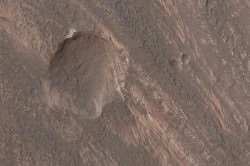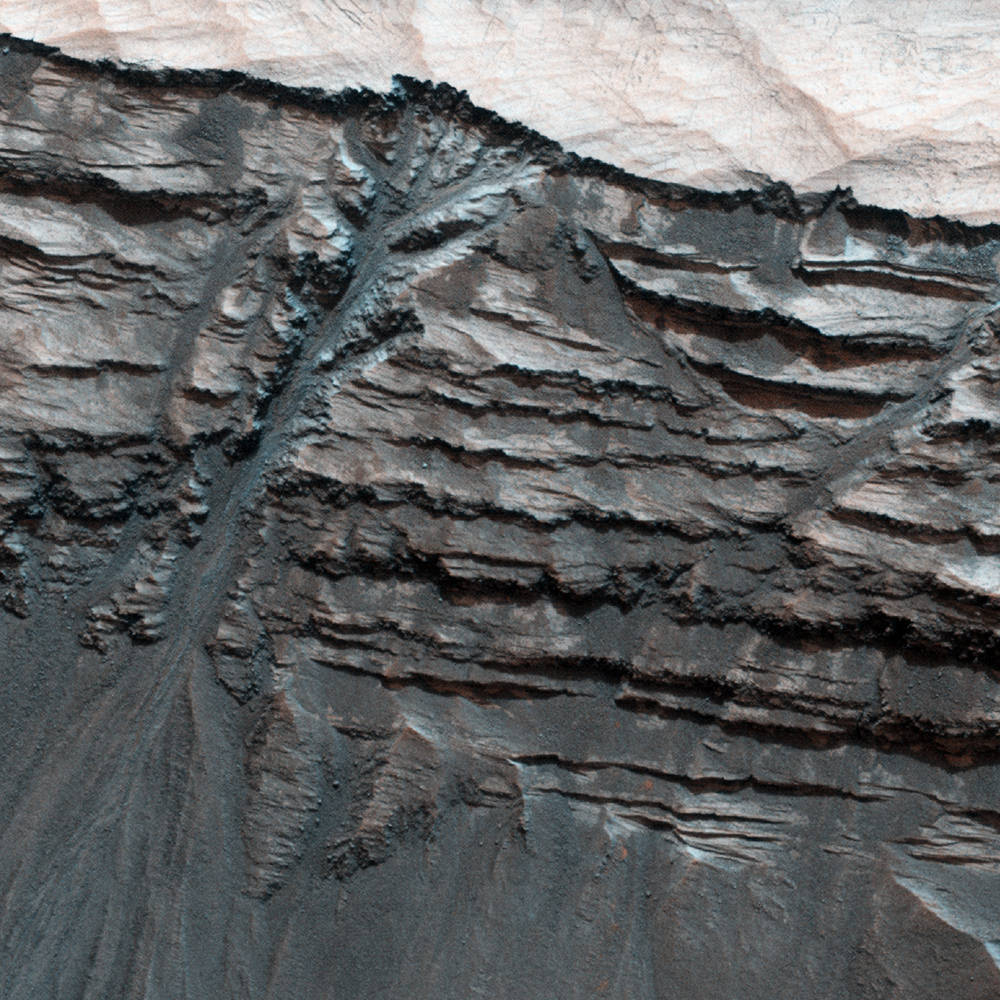[/caption]
Terby Crater, a 170-km-wide (100-mile-wide) crater located on the northern edge of the vast Hellas Planitia basin in Mars’ southern hemisphere, is edged by variable-toned layers of sedimentary rock – possibly laid down over millennia of submersion beneath standing water. This image (false-color) from the HiRISE camera aboard the Mars Reconnaissance Orbiter shows a portion of Terby’s northern wall with what clearly looks like liquid-formed gullies slicing through the rock layers, branching from the upper levels into a main channel that flows downward, depositing a fan of material at the wall’s base.
But, looks can be deceiving…

Dry processes – especially on Mars, where large regions have been bone-dry for many millions of years – can often create the same effects on the landscape as those caused by running water. Windblown Martian sand and repetitive dry landslides can etch rock in much the same way as liquid water, given enough time. But the feature seen above in Terby seem to planetary scientists to be most likely the result of liquid erosion… especially considering that the sedimentary layers themselves seem to contain clay materials, which only form in the presence of liquid water. Is it possible that some water existed beneath Mars’ surface long after the planet’s surface dried out? Or that it’s still there? Only future exploration will tell for sure.
“While formation by liquid water is one of the proposed mechanisms for gully formation on Mars, there are others, such as gravity-driven mass-wasting (like a landslide) that don’t require the presence of liquid water. This is still an open question that scientists are actively pursuing.”
– Nicole Baugh, HiRISE Targeting Specialist
Terby Crater was once on the short list of potential landing sites for the new Mars Science Laboratory (aka Curiosity) rover but has since been removed from consideration. Still, it may one day be visited by a future robotic mission and have its gullies further explored from ground level.
Click here to see the original image on the HiRISE site.
Image credit: NASA / JPL / University of Arizona


This comment has nothing to do with this interesting article, but, does any one know what has happened to HSBC? I sort of miss his biting commentary, at least for the entertainment. Just wondering.
I think he’s posting his comments as ‘Andrew James’ now.
Look at his comments e.g. on ‘Astronomy Without A Telescope – Cosmic Magnetic Fields’ (april 30): same old HSBC style. I had a good laugh when I realised this. He probably couldn’t resist to continue his mission to fight pseudoscience, after Nancy’s remark. If I’m wrong, and you miss Crumb’s commentary, then just read Andrew’s comments as if they were written by Crumb; same experience.
Ha. Andrew James…aka Salacious B. Lite. 😉
Shorter nym, in any case. Which my fingers notes thankfully.
Have they narrowed down any more landing sites for MSL?
Last I heard there are 4 candidates to be considered: Eberswalde Crater, Gale Crater, Holden Crater and Mawrth Valley. Should have a decision in a couple of weeks.
Can’t wait!
Certainly that’s a sedimentary rock formation, deposited under liquid. But the gullies look very much like the type of dry landslips we get in the Pilbara. The slide can be triggered by a heavy rainfall, such as accompanies a tropical cyclone, but the actual slide and erosion is a dry process and doesn’t need rain.
I disagree with the sweeping statement that clay minerals, only form in liquid water. Clay which is made up of minerals such as biotite, muscovite, phlogopite, lepidolite and illite are found as primary minerals in igneous rocks such as granite and lava and in metamorphic rocks in banded layers such as altered granites like gneisses and schists from altered basalts and tuffs (igneous). Alteration of feldspars to micas or clay minerals is also possible under metamorphic conditions.
These metamorphic banded horizons can be many kilometers thick. Many can have a sedimentary origin, but it is not necessary.
We must not assume that a banded layered horizon is sedimentary. It could just as easily be banded volcanic, basaltic or metamorphic like amphibolite-chlorite-serpentinite-schists as found in the ancient greenstone belts of 3.5 to 4 billion years old around Earth in Africa (Barberton Mountain Land), Canada, Russia and Australia.
Clay minerals in rock do not mean liquid water or a sedimentary origin. Geology 101
.
Just as the presence of methane or oxygen does not mean an organic source, clay minerals do not mean liquid water.
Chris Landau
” a 170-km-wide (100-mile-wide) crater ” its quite big……. it proves that there was a lot amount of water on mars….. still the weathered pebbles can give more proof about the rate of flow and deposits..